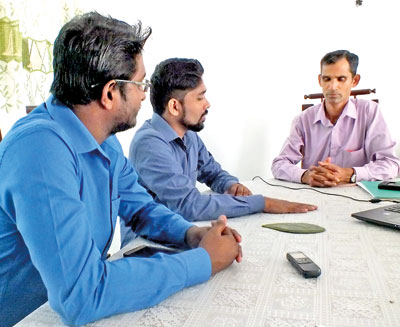Young Lankan inventors develop path-breaking remote-controlled underwater camera
They are two youngsters who, when reaching senior classes in school forms, started treading on paths where others of their age never thought of.

Inventor duo Gayashan De Alwis and Kasun Hasantha discuss improvements to ROV with Shantha Sri of NSF. (Below)-The high pixel video camera fixed to the ROV that could relay continuous video to the ground
Gayashan de Alwis, after completing his tertiary education, read in a newspaper about a lost city submerged in undersea somewhere in the Aegean Sea. As he recollects he could just remember the name of the submerged city as ‘Kane’ lying in the ocean between Greece and Turkey. According to archaeologists and oceanographers, the remnants of this massive city dates back to 4,500 years and 8000 years in a 12 acre area.
A complete dreamer, he was not interested in archaeology, but his dream was whether some day he could invent an ROV (Remotely Operated Underwater Vehicle) that could be sent to this location to make a comprehensive research on this lost city.
While he is entertaining this basic idea of the ROV somewhere in 2010, he joined the Ocean University of Sri Lanka at Mattakkuliya to the Faculty of Engineering where the study courses are on Fisheries, Marine Science, Marine Logistics and Transport Management. Luck struck when he came across Kasun Hasantha a fellow undergraduate following the same line of Ocean Engineering and having the same dream of developing an ROV.
The duo then began to work very hard on their dream, examining all the available research on which they could lay their hands on. First they analysed, drew and prepared a blueprint on the entire components and prepared a complete report.
They felt that the task was extremely difficult as the only way to construct this ‘dream ROV’ was to import the components, and it would be a worthless attempt as the imported parts would be extremely expensive. For whatever it was worth, they submitted their report to the university and the university accepted their ‘Research Report’ and was gracious enough to offer a grant of Rs. 40,000 to start with.
With this ‘shot in the arm’, the duo themselves became machines as the only alternative was to turnout all the components with local raw material and in local workshops by them alone, while for this purpose the funds were barely insufficient. Every part they designed, drew and documented turned out to be successful in maintaining the cost at the cheapest level. The other important factor was to make every component at very high precision level.
Then they learnt of the National Science Foundation (NSF) which was offering grants to this type of science and technology – based projects. Last week, J. Santha Sri, Head of Scientific Unit, NSF accompanied the Business Times to Maharagama where the duo was assembling their ‘dream’ ROV.
Mr. Shantha said the grant offered by NSF was nearly half a million rupees and one of the objectives of the Technology Grant Scheme of NSF is to support technology development within the country which leads to successful products/processes as import substitutes. One of the barriers for industry to use ROVs is the high cost.
He said that addressing this issue, the above grantee had submitted a proposal to develop a functional prototype of remotely operated underwater vehicle (ROV) for the benefit of the country and mentioned that ROVs are used for a variety of underwater operations particularly in situations when it is not practically possible or when it is unsafe for a person to go and perform a task personally. With the NSF funding support, the grantees were able to develop the functional prototype of the ROV successfully.
Mr. De Alwis said that if the apparatus is to be imported, it would cost somewhere around Rs. 10 million and also if the parts are imported and assembled they would incur the same amount of cost. As they have successfully turned out the components locally the cost of the unit has come down to minimal levels as the first prototype ROV which they so meticulously assembled cost them little more than Rs. 100,000. The project was initially based on the university grant of Rs. 40,000 and the balance they have supplemented with their salaries earned in their jobs.
The first prototype ROV, in fact, failed as they encountered certain technical defects where the machine refused to submerge. But with the funds offered by the NSF they were able to turn out all the parts locally and the second model assembled was highly successful and when it was tested at the Trincomalee naval base recently the new ROV worked very well and it is now ready to engage in any undersea research work.
The ROV inventors’ intention is to hire this instrument to any prospective user. They are also exploring the possibility of turning out several of them, provided they find an investor, and exporting to neighbouring countries.
The ROV is named ‘Magura’, a local fish which is famous in penetrating the muddy bottoms of rivers. The ROV is fixed with high pixel video camera which could relay continuous video to a monitor on the ground and also equipped with flash lights and the sensors that could scan the bed of the sea.
The inventors said that this instrument could be utilised in the ship building or ship repairing industry. The ROV could be used to find out the defects in the hull before the ship is dry-docked and thus the extent of the repairs could be estimated and carried out accordingly.
The advantage of using the ROV for underwater research is that deploying men for this purpose is dangerous as humans are constrained in going to deep areas of the ocean.
The inventors said that they can develop this instrument to utilise for more advanced research, if needed. Gayashan De Alwis could be reached on 071 0582826 and Kasun Hasantha could be reached on 076 6500720.


